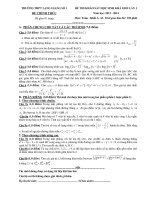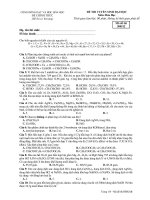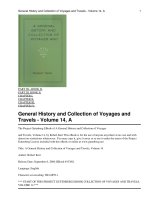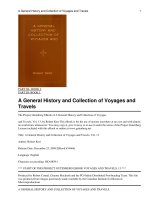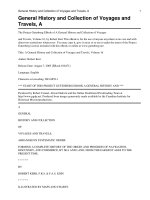Study a new atmospheric freeze drying system incorporating a vortex tube and multi mode heat input 1
Bạn đang xem bản rút gọn của tài liệu. Xem và tải ngay bản đầy đủ của tài liệu tại đây (57.9 KB, 8 trang )
Chapter 1 Introduction
CHAPTER 1
INTRODUCTION
1.1 Background
With increasing trend towards new and better quality dried products and the added new
requirement of natural resource conservation and sustainability, the development of
appropriate drying technologies has become increasingly important.
Removal of water can be achieved in a number of ways. Proper dehydration of highly
heat sensitive products requires a controlled supply of heat for vaporization or
sublimation and concurrent removal of the water vapor generated. The structure and
properties of the material to be dried are not altered much by the freeze-drying process.
This technique has been widely applied industrially to the drying of biological
materials, pharmaceuticals, and foodstuffs (Liapis and Bruttini, 2007). The main
disadvantages of this technique are its high fixed and operational costs. The
atmospheric freeze drying techniques is an outcome of recent efforts over the last two
decades to respond to this challenge. It combines the advantages of both freeze-drying
(high product quality) and convective drying (low process costs), along with some of
their limitations as well.
1.2 Vacuum Freeze Drying (VFD) Process
VFD is a process where the wet product is first frozen to a solid phase and
subsequently dried by sublimation of the ice layer to the vapor phase without passing
through the liquid phase at atmospheric pressure, by exposing it to a very low partial
pressure of water vapor, while supplying heat of sublimation. Heat must be supplied by
conduction or convention carefully to avoid melting of ice.
1
Chapter 1 Introduction
2
Figure 1.1 Phase diagram of water
The phase diagram of the freeze drying process is shown in Figure1.1 (Ratti, 2008).
Water can exist in three different states: solid, liquid or gas (vapor) depending on the
pressure and temperature. Point T in Figure1.1 represents the triple point of water (at
0.01
o
C and 0.612 kPa) where the three phases coexist, and point C is the critical point
of water (374
o
C and 22060 kPa). The basic idea of freeze drying is to make use of
sublimation phenomena and it starts at temperatures lower than 0.01
o
C, and vapor
pressures below 0.612 kPa. For freeze drying, it will follow the path from A to point D
i.e. the product should be first frozen by decreasing its temperature, then the water
vapor pressure should be lowered below the pressure corresponding to the triple point,
and finally some heat should be supplied to help the ice to convert into by sublimation.
Usually freeze drying works at higher vacuum (pressure levels range from 0.000013 to
0.612
101.330
100 0.01
Pressure (kPa)
Temperature (
o
C)
T
A
D
C
Solid
Liquid
Fusion
Vapor
Sublimation
Evaporation
Chapter 1 Introduction
0.0013 bar). The driving force for the migration of sublimated vapor towards the
surface of the product depends on the difference between partial pressure of water
vapor around the product surface (p
s
) and vacuum pressure inside the drying chamber,
as shown in Figure 1.2.
G
c
p
c
p
c
/
p
/
s
G
p
s
Figure 1.2 Schematic diagram of vacuum freeze drying
Freeze-drying is an attractive process for drying foods since it retains in the dried form
material properties such as shape, appearance, taste, color, flavor, texture, and
biological activity, and also permits fast rehydration in cold or hot water. In addition,
low content of micro-organisms, long shelf life, accurate dosing and low final moisture
content are also some of the distinguishing advantages of the freeze drying. However,
high capital and energy costs which stem from the need to generate and maintain very
low temperatures and very high levels of vacuum, make it an expensive process.
Moreover, the operation is a lengthy one due to the low thermal conductivity in a
rarefied atmosphere and the small difference in exchange potential at low pressures. To
minimize the drawbacks noted above, efforts have been under way to develop an
3
Chapter 1 Introduction
atmospheric freeze drying process as a promising alternative cost-effective method.
The main advantages of this process are simplification of the equipment due to the
absence of a vacuum chamber and ancillary equipment and significant reduction in
energy costs.
1.3 Atmospheric Freeze Drying (AFD)
Meryman (1959) first showed in the laboratory the possibility of freeze-drying
products at atmospheric pressure. In a series of experiments, he showed that the
diffusion of water vapor from the drying boundary through the dried shell occurs by
vapor pressure gradient, rather than by the absolute pressure on the system. Hence, it is
possible to freeze-dry at atmospheric pressure. This process is accomplished by
circulating cold dry air below -6
o
C to -10
o
C over a frozen product to improve the heat
and mass transfer from the frozen material at near atmospheric pressure. The only
absolute requirement is that the partial pressure of water vapor in the drying medium
be kept low enough to provide a mass transfer driving force for water vapor transfer
from the frozen sample. The temperature must be low enough to maintain frozen
integrity of product and should maximize the vapor pressure of products. Heldman and
Hohner (1974) analyzed the kinetics of freeze drying with a simple one-dimensional
model under atmospheric freeze drying presented schematically as shown in Figure 1.3.
According to the one-dimensional model, the ice interface (f) recedes to the interior as
heat of sublimation (Q) flows from the surface (s) to the interface to a temperature
gradient (T
a
) represented by the dotted line curve. Simultaneously, water vapor flows
through the dry layer in response to the water vapor pressure (P
va
) gradient represented
4
Chapter 1 Introduction
5
by the solid line curve.
Figure 1.3 Schematic diagram of atmospheric freeze drying (f- interface; s-surface; Q-
heat transfer; m-mass transfer; T
a
-temperature gradient; P
va
-partial pressure gradient;
p
s
- partial pressure of water vapor around the product surface; p
va
- partial pressure of
water in the drying chamber)
Despite the promises of low energy consumption and better quality product, certain
problems still exist in the atmospheric freeze drying process, limited to practical
implementation. Conventional atmospheric freeze dryers utilize a bulky system of
mechanical heat pump system to lower temperature and a condenser to reduce
humidity of the air. At least two mechanical agents are required for this operation,
which does not seem economical from the energy point of view.
It also takes time to setup, de-humidify and cool the drying chamber. In addition,
atmospheric freeze drying is controlled by internal resistance heat and mass transfer
due to the lower vapor diffusivity at atmospheric pressure which makes it a slower
drying process. Difficult to control the structure of the frozen products, abrasion of
dried product is too large, and the separation of the adsorbent is not complete enough
Ice
Layer
………………………………………………
………………………………………………………………………
………………………………………………………………………
………………………………………………………………………
………………………………………………………………………
………………………………………
…
……………………………… ….…
Dry
Layer
(f)
(s)
Q
m
p
va
p
s
T
a
P
v
a
x
y
Cold
dry air
Chapter 1 Introduction
are the drawbacks of atmospheric fluidized-bed drying system listed by Khan-Wyler
(1987).
1.4 Vibrating Bed with Multimode Heat Input and Vortex Tube
Conventional atmospheric freeze dryers utilize a system of mechanical heat pump
system to lower temperature and in turns reduce the humidity of the air. It takes time to
setup, de-humidify and cool the drying chamber. To overcome the above limitations, a
vortex chiller for the purpose of cooling and de-humidification (Scheper, 1951)
coupled with multimode and intermittent heat input by conduction and radiation can be
used to speed up AFD process.
The vibro-fluidized bed offers lower power needs, attrition rates and elutriations rates
than gas-fluidized beds (Rogelio et al., 2000). The vibrating state of the bed allows
higher heat and mass transfer rates due to de-agglomeration and the consequent
increase of specific area in the gas-solid contact (Gupta et al., 1980). To further
improve the drying kinetics and quality of the product as well as reducing the energy
consumption on AFD system, osmotic dehydration is a suitable option of partial
removal of water by soaking foods, mostly fruits and vegetables in hypertonic
solutions prior to start the drying operation (Alakali et al, 2006). Therefore, a vibro-
fluidized bed coupled with vortex tube and multimode heat input under atmospheric
pressure is proposed an attractive option to overcome the limitations of atmospheric
freeze drying using a fluidized bed. No prior work exists on this new drying concept.
6
Chapter 1 Introduction
1.5 Objectives
The main objective of this research is to develop new atmospheric freeze drying
system for drying of heat sensitive materials. To reach this goal, a laboratory scale
atmospheric freeze drying system consisting of a vortex tube, a vibro-fluidized bed and
an adsorbent is designed to permit simultaneous or intermittent application of
conductive and radiant heat input for drying of food materials. An experimental
approach is employed to carry out a systematic parametric evaluation over a range of
parameter values. The sub-objectives of this project are as follows:
z To study experimentally the effect of different operating variables on the drying
kinetics and quality in the vibrating bed atmospheric freeze drying process.
z To develop a mathematical model to capture the drying kinetics of AFD along
with the effects of affecting parameters (product thickness and carrier gas
temperature) on drying rate.
• To carry out computational fluid dynamic studies of the vortex tube for the
investigation of flow behavior and heat transfer.
1.6 Scope
z Design, fabricate and test a novel vibro-fluidized bed using a vortex tube to supply
subzero temperature air and selective adsorbent and multimode heat input through
conduction and radiation under atmospheric pressure. Effect of adding an
adsorbent to the bed of drying material is also examined.
z Compare the physical quality parameters (e.g. color, rehydration behavior, shape,
size and microstructure) and drying characteristics of selected model heat-
7
Chapter 1 Introduction
8
sensitive materials with heat pump drying, vacuum freeze drying and atmospheric
freeze drying in a vibro-fluidized bed.
z To investigate the effect of osmotic dehydration prior to AFD on the drying
kinetics and quality parameters in the vibro-fluidized AFD system.
z To develop a mathematical model simulates to the AFD drying process and
compare simulation results with experiments for validation of the model.
z A computational fluid dynamic study of vortex tube performance to model the
flow behavior and associated energy separation process.
Appendix: Appendix A presents results of experimental and modeling studies using a
heat pump dryer. These experiments were done to allow comparison with AFD results.
Appendix B includes results of osmotic dehydration while Appendix C presents
experimental results showing effect of vibration on bed hydrodynamics.



